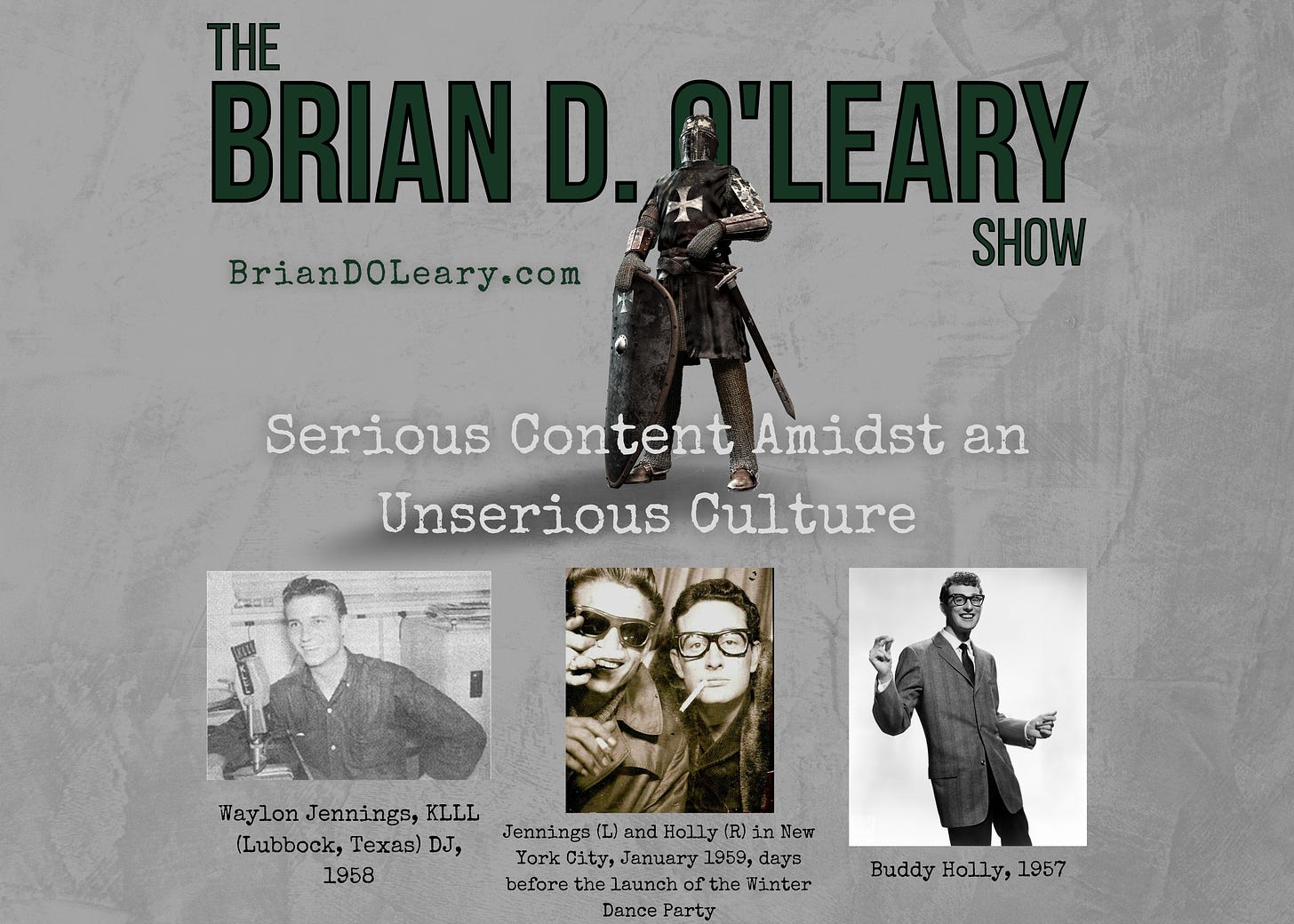The Brian D. O’Leary Show
February 3, 2023
Today’s show brought to you by O’Leary Beef and Southside Market & Barbecue.
Set up your “Big Game” party with pit-roasted meats from Texas delivered to your front door.
Fountain.FM
Listen and support us at the same time over at Fountain.FM
A tragic day, but “the Music” continued
The legendary rock ‘n’ roller Buddy Holly headlined a package show in early 1959, known as the Winter Dance Party.
The itinerary was bananas. It covered twenty-four Midwestern cities in twenty-four days—there were no off days.
The tour schedule crisscrossed the upper Midwest with no apparent logic. Overnight jaunts of several hundred miles—all in sub-freezing temperatures—were commonplace.
Holly historian Bill Griggs had this to say about General Artists Corporation (GAC)—the operation which booked the tour:
They didn’t care. It was like they threw darts at a map… The tour from hell—that’s what they named it—and it’s not a bad name.
On February 2nd, the show in Clear Lake, Iowa ended, and the tour headed about 400 miles northwest from Clear Lake to Morehead, Minnesota.
Holly famously chartered a plane for his band prior to the show. Buddy was concerned with getting some rest and making a head start to take care of some much-needed laundry for him and his tour mates.
Ultimately, only the headliners of the show took the charter.
Waylon Jennings, then playing bass guitar in Holly’s band, said he felt more comfortable riding on the tour bus and voluntarily gave up his seat to J.P. Richardson, the Beaumont, Texas disc jockey and tour co-headliner, known as The Big Bopper.
Richardson felt ill and needed rest.
The Winter Dance Party consisted of several contemporary and would-be stars.
Yet the party ended on February 3, 1959, for the 22-year-old Holly and 28-year-old Big Bopper when the plane went down in a blizzard shortly after takeoff, five miles northwest of Mason City, Iowa.
Also perishing in the infamous crash was 17-year-old Ritchie Valens of “La Bamba” fame.
Yet the tour played on. Sadly, in retrospect.
Future chart-topper Bobby Vee, then but 15-years-old, had Buddy Holly's material down cold. So, the Minnesota child filled in—in place of Holly—on February 3 in Morehead.
Jimmy Clanton, Frankie Avalon, and Fabian ultimately finished the tour in the place of the deceased stars.
Waylon couldn't get to Holly's funeral. GAC wouldn’t let him leave the tour.
To add insult to injury, venue managers regularly threatened non-payment for shows because the original headliners didn't appear. It didn’t matter that they had perished in a tragedy.
After the crash, Jennings continued for two more weeks on the tour with doo-wop stars Dion and the Belmonts amongst others. Lead singer Dion DiMucci is the last original headliner still alive today and is in his early 80s.
Jennings returned to Lubbock, Texas after the tour ended. Holly’s father looked after young Waylon.
In Waylon: An Autobiography, Jennings wrote: “Mr. Holley wanted to promote me, because he said Buddy believed in me, but I had enough sense to know that wouldn’t be right. He bought me clothes and things like Buddy would.”
Waylon returned to the job that got him noticed by Buddy Holly in the first place, as a radio disc jockey. He bounced around west Texas and Arizona as a DJ for the better part of a decade before he reappeared in the public consciousness as a musician once again in the late 1960s.
So, contrary to the schmaltz unleashed by Don McLean in 1971, “music" did not die that day.
It is more than unsettling that American Pie, McLean’s terrible—and entirely too long of a—song, is what the hacky news sites reference on a day like this, the anniversary of the plane crash. But never fear, it happens every February 3rd.
Diving into the McLean biography is more than a little unsettling as well. To wit: after his second divorce (from his wife of nearly 30 years) with accusations of abuse hanging over him, the now 77-year-old McLean took up with a “model and reality star” 48 years his junior.
McLean still lives off the reputation of that crappy half-century-plus old song.
Unfortunately, in my early twenties, I purchased some McLean music, but it was because it was a double-album of McLean’s and Jim Croce’s music.
Croce was good, if not great. He also died in a tragic airplane crash. We wrote about Croce a while ago.
Anyway, this is all a long way of saying, rock out to some Buddy Holly today, or sing along with “La Bamba,” or get a little “Chantilly Lace” pumping through the airwaves.
Perhaps go with a doo-wop session of Dion and the Belmonts. “The Wanderer” by Dion when he went solo is also a great tune.
There is never a bad day to play Waylon Jennings music or play it loud.
I already listened to the horrible American Pie today. I can confirm that it is as bad as I remember and I feel like less of a man for not trusting my memory.
Links:
For your premium meats: O’Leary Beef
For all the rest of it, go to BrianDOLeary.com for more information.

















A tragic day, but “the Music” continued